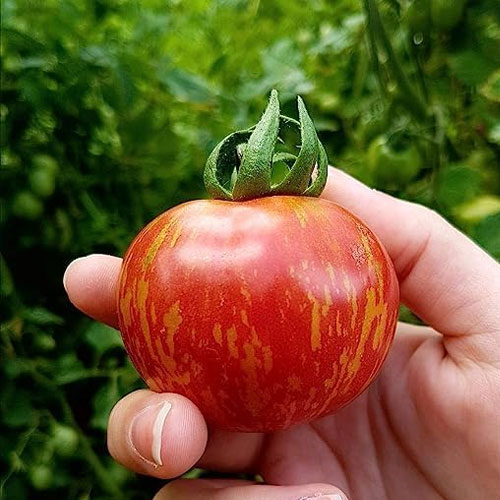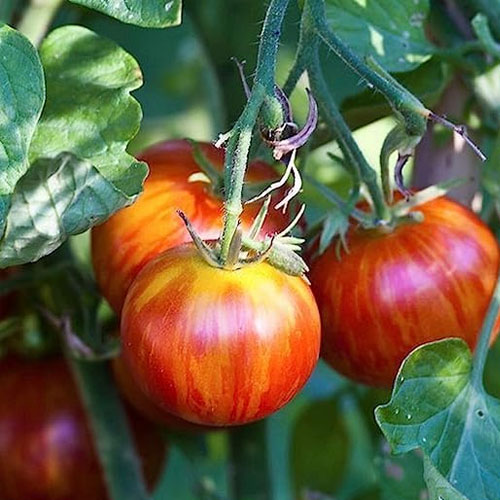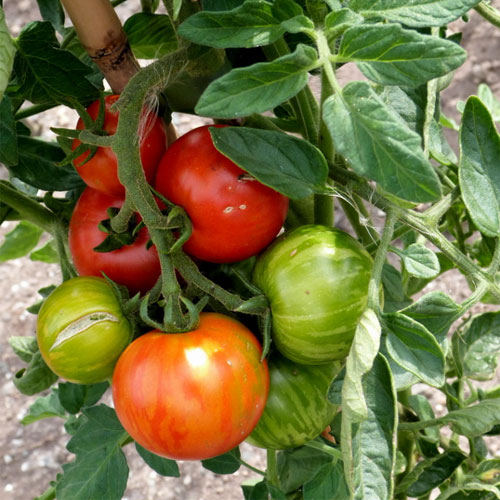Total Number of seeds: 20
Add an exotic twist to your garden with Tigerella Tomato Seeds, a rare heirloom variety known for its striking red skin with bold yellow stripes. These tomatoes are not just beautiful — they also offer a sweet, rich flavor and an early harvest. Closely related to the Green Zebra tomato, the Tigerella stands out with its red base color and extra sweetness, making it a perfect choice for salads, sandwiches, or snacking straight off the plant.
If you’re looking for a colorful, fast-maturing, productive tomato variety, Tigerella is a must-have. Its 2–4 oz fruits grow quickly, making it ideal for Indian climates, balconies, and container gardening.
Variety Name: Tigerella
Type of Seed: Heirloom, Open-Pollinated, Non-GMO
Germination Time: 6–10 days
Sunlight Requirements: Full sun (6–8 hours daily)
Growing Locations: Pots, containers, grow bags, garden soil
Growing Season: Spring to early Monsoon (Feb–July)
Seed Sowing Depth: 0.5–1 cm
Ideal Climate: Warm (18°C to 32°C)
Plant Height: 3–5 feet (semi-determinate to indeterminate)
Fertilizer Needs: Organic compost every 2 weeks
Life Span: 90–120 days
Ideal Growing Temperature: 22°C to 30°C
Harvesting Time: 60–70 days from transplanting
Maintenance Required: Moderate
Watering Frequency: Once every 2–3 days or when topsoil is dry
Ideal Grow Bag Size: 12x12 inches or larger with proper support



Tigerella Tomatoes perform well in Indian climates, especially during February to July. In warmer southern states, a second crop can be sown in September–October. With full sun and compost-rich soil, Tigerella matures quickly and produces consistent harvests, even in balcony setups.
Use a 12 x 12 inch grow bag or bigger. Fill with fertile soil mixed with organic compost. Sow 2–3 seeds per pot, cover lightly with soil, and water gently. Once seedlings sprout, thin out the weakest and support the growing plant with a stake or cage. Place the pot in a sunny location and water regularly.
Preparation: Use seed trays or small pots filled with moist potting mix
Sowing: Sow seeds 0.5–1 cm deep
Watering: Keep soil moist but not soggy
Germination: Occurs in 6–10 days
Transplanting: After 25–30 days or when 5–6 true leaves appear
Sunlight: Ensure full sun exposure for best fruiting
Soil: Loamy, nutrient-rich, well-draining soil
Fertilization: Feed with vermicompost, seaweed extract, or organic manure
Pruning: Remove lower leaves and side shoots to encourage airflow
Support & Spacing: Use a tomato cage or stake; allow 2–3 feet between plants
Pest Control: Monitor for aphids and caterpillars; use neem oil sprays
Disease Prevention: Ensure good air circulation; water at base only
Mulching: Retain moisture using straw or dry leaves
Harvesting: Pick when fruits turn red with clear yellow tiger-like stripes
1. Apply Nutrient-Rich Fertilizers
When your plants begin flowering, use nutrient-rich fertilizers like Organic Bone Meal Powder or Vermicompost. This helps in boosting the bloom and enhances overall yield.
2. Use Organic Fertilizers
Feed your plants with organic fertilizers such as Cow Dung Manure or Neem Cake. Organic options promote healthy soil life.
3. Regular Feeding
Apply fertilizers every 20-25 days to ensure plants receive a steady supply of nutrients. Choose from various options like Cocopeat Compost for moisture retention.
Bi-Colored Beauty: Red tomatoes with bright yellow stripes — naturally ornamental
Early Maturing: Yields start in just 60–70 days from transplant
Sweet & Juicy: Sweeter than Green Zebra, with a juicy bite
Compact Growth: Suitable for pots, terraces, and home gardens
Continuous Producer: Produces abundantly throughout the season
Delicious in salads, salsas, sandwiches, and pasta dishes
Rich in antioxidants, Vitamin C, and lycopene
Perfect for kids' lunchboxes due to its vibrant color and size
Adds visual interest and a gourmet touch to any dish
Suitable for urban gardening, terrace farming, and organic setups
Avoid overwatering, especially during monsoon
Provide strong support early to prevent stem breakage
Do not let the fruit over-ripen on the plant; harvest promptly
Space out plants to prevent fungal infections and rot
Protect seedlings from birds or snails with netting
Problem: Yellowing leaves
Solution: Add compost tea or iron-rich fertilizers
Problem: Blossom end rot
Solution: Ensure calcium availability and consistent watering
Problem: Cracking fruits
Solution: Maintain even watering and avoid overwatering during ripening
Tiger Tomato, Tiger Striped Tomato, Yellow Line Tomato, Cheriya Varna Thakkali, Baagh Lined Tomato, Sona Patta Wala Tamatar, Rangwala Tomato
Q: Is Tigerella a hybrid?
A: No, it's a heirloom open-pollinated variety with stable characteristics.
Q: Can I grow it in hanging pots?
A: Yes, but ensure strong support as the vines are medium to long.
Q: Does it need a lot of care?
A: Moderate care; basic sunlight, compost, and occasional pruning are sufficient.
Sign in now to receive a 5% instant discount on your first order when using code WELCOME. Begin your organic journey today!
By logging in, you're agreeing to our Terms of Service and Privacy Policy.
Priya Singh
Bahut acchi variety hai, colorful aur flavorful tomatoes mile. Recommended.
Suresh Reddy
Good yield mila aur plants strong rahe. Soil me healthy growth dikhayi di.
Ritika Jain
Beautiful bi-color fruits aaye. Harvesting 65 days me start ho gayi. 🌿
Manoj Pillai
Seeds organic aur fresh the. Plant fast grow kar gaya aur taste superb hai.
Kavita Menon
Fruits striped aur attractive bane. Plant disease-free raha. Best tomato seeds!
Vikram Rao
Golden Hills Farm se seeds order kiya aur result excellent mila. Germination 95% tha.
Anjali Joshi
Container gardening ke liye perfect hai. Yield achha mila aur fruits fresh the.
Deepak Patil
Seeds pure variety ke the. Fruits ka color aur pattern same jaisa photo me tha.
Sneha Nair
Germination quick tha aur fruits ka flavor superb. Garden me kaafi achha yield mila. 🌸
Arjun Singh
Plant ka growth moderate tha par fruits healthy aaye. Organic fertilizer use kiya tha.